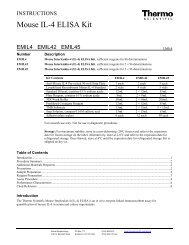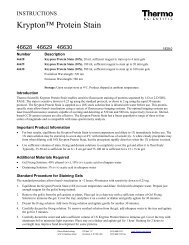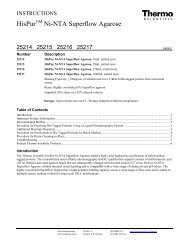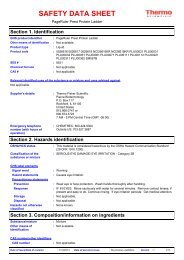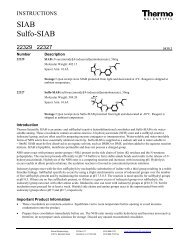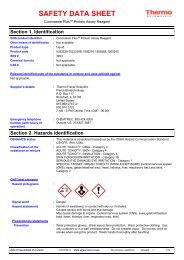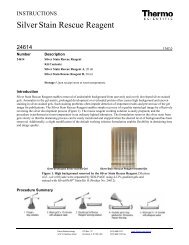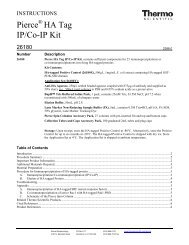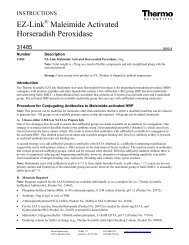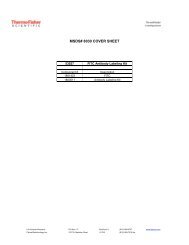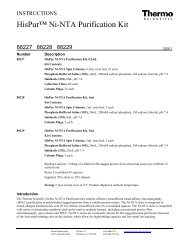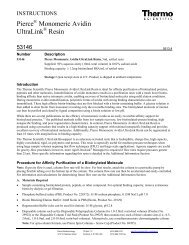Thermo Scientific Pierce Protein Assay Technical Handbook Version 2
Thermo Scientific Pierce Protein Assay Technical Handbook Version 2
Thermo Scientific Pierce Protein Assay Technical Handbook Version 2
You also want an ePaper? Increase the reach of your titles
YUMPU automatically turns print PDFs into web optimized ePapers that Google loves.
Introduction<br />
Selection of the <strong>Protein</strong> <strong>Assay</strong><br />
When it is necessary to determine the total protein concentration<br />
in a sample, one of the first issues to consider is the selection of<br />
a protein assay method. The choice among available protein<br />
assays usually is based upon the compatibility of the method with<br />
the samples to be assayed. The objective is to select a method<br />
that requires the least manipulation or pre-treatment of the<br />
samples containing substances that may interfere with the assay.<br />
Table 1. <strong>Thermo</strong> <strong>Scientific</strong> <strong>Pierce</strong> <strong>Protein</strong> <strong>Assay</strong> Reagents and their working ranges.<br />
Introduction<br />
<strong>Protein</strong> quantitation is often necessary prior to handling protein<br />
samples for isolation and characterization. It is a required step<br />
before submitting protein samples for chromatographic, electrophoretic<br />
and immunochemical separation or analyses.<br />
The most common methods for the colorimetric detection and<br />
quantitation of total protein can be divided into two groups based<br />
upon the chemistry involved. <strong>Protein</strong> assay reagents involve<br />
either protein-dye binding chemistry (Coomassie/Bradford) or<br />
protein-copper chelation chemistry. We offer numerous colorimetric<br />
assays for detection and quantitation of total protein. They<br />
are all well-characterized, robust assays that provide consistent,<br />
reliable results. Collectively, they represent the state-of-the-art<br />
for colorimetric detection and quantitation of total protein.<br />
Reagent<br />
<strong>Pierce</strong> 600nm<br />
<strong>Protein</strong> <strong>Assay</strong><br />
Coomassie (Bradford)<br />
<strong>Protein</strong> <strong>Assay</strong><br />
Coomassie Plus<br />
(Bradford) <strong>Assay</strong><br />
BCA <strong>Protein</strong><br />
<strong>Assay</strong> – Reducing<br />
Agent Compatible<br />
BCA <strong>Protein</strong> <strong>Assay</strong><br />
Micro BCA<br />
<strong>Protein</strong> <strong>Assay</strong><br />
Modified Lowry<br />
<strong>Protein</strong> <strong>Assay</strong><br />
Protocol Used<br />
Standard tube<br />
Standard microplate<br />
Standard tube or microplate<br />
Micro tube or microplate<br />
Standard tube or microplate<br />
Micro tube or microplate<br />
Standard tube or microplate<br />
Standard tube or microplate<br />
Enhanced tube<br />
Standard tube<br />
Standard microplate<br />
Standard protocol<br />
Standard microplate<br />
Estimated<br />
Working Range<br />
25-2,000µg/mL<br />
50-2,000µg/mL<br />
100-1,500µg/mL<br />
1-25µg/mL<br />
100-1,500µg/mL<br />
1-25µg/mL<br />
125-2,000µg/mL<br />
20-2,000µg/mL<br />
5-250µg/mL<br />
0.5-20µg/mL<br />
2-40µg/mL<br />
1-1,500µg/mL<br />
10-1,500µg/mL<br />
Each method has its advantages and disadvantages (see pages<br />
1-3). Because no one reagent can be considered to be the ideal or<br />
best protein assay method, most researchers have more than one<br />
type of protein assay reagent available in their labs.<br />
If the samples contain reducing agents or copper chelating<br />
reagents, either of the ready-to-use liquid Coomassie dye<br />
reagents (Coomassie [Bradford] <strong>Protein</strong> <strong>Assay</strong> or the Coomassie<br />
Plus <strong>Assay</strong>) would be excellent choices.<br />
4<br />
For more information, or to download product instructions, visit www.thermoscientific.com/pierce



